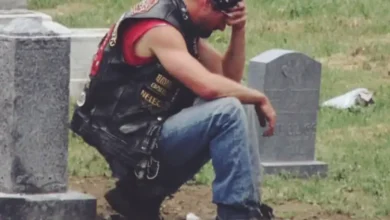MY DAUGHTER WAS THRILLED TO HOLD HER NEWBORN SISTER, UNTIL SHE WHISPERED ONE WORD THAT SHOOK ME TO MY CORE!

The Hat
When I first heard that Jaden refused to take off his hat, I figured it was just another dress-code snag. A typical Tuesday morning — coffee cooling on my desk, papers stacked in uneven piles, the soft buzz of middle school life beginning its day. Then the phone rang.
“Can you come down to my classroom?” the teacher asked, her tone uneasy. “It’s Jaden. He won’t remove his hat. But… I think something else is going on.”
I knew Jaden — quiet, polite, the kind of student who faded into the background. If he was standing his ground, there had to be more to it.
When I walked into the room, the chatter stopped. Jaden sat apart from everyone, shoulders tight, hat pulled low, hands clenched in his lap like he was holding himself together.
“Hey, Jaden,” I said softly. “How about we step out for a minute?”
He nodded, never looking up.
Back in my office, he stayed silent. The hat stayed on. When he finally spoke, his voice trembled. “Please don’t make me take it off.”
I pulled up a chair beside him. “You know the rule,” I said gently, “but if there’s a reason, I’ll listen.”
He hesitated, his whole body shaking slightly. Then, in a voice small and breaking, he said, “The kids laughed at me. Said my hair looks weird. Patchy.”
I leaned closer. His face was pale. What I heard wasn’t embarrassment — it was pain. And underneath it, shame.
“Jaden,” I said quietly, “if you’re okay with it, I can fix it up a bit. I’ve cut hair before.”
After a long pause, he nodded.
When I carefully lifted the brim, my breath caught. His scalp showed uneven patches — and faint scars. Thin, silvery lines that told a story no child should have to carry.
I said nothing. Just began trimming, slow and careful, the scissors clicking softly in the silence.
After a while, he whispered, “My mom’s boyfriend did it. He got mad. Said I was being smart. I wasn’t.”
My hand stopped.
I’d helped kids through hard things before, but this was different. This wasn’t disobedience. It was survival.
When I finally found words, I said, “I’m so sorry, Jaden. None of this is your fault. You didn’t deserve it.”
He gave a tiny nod. When I finished, I handed him a mirror. He stared for a moment, then smiled — just barely, but it was real.
The Weeks After
I made sure to check in with him — a nod in the hallway, a few quiet minutes at lunch. I didn’t push. I just wanted him to know he wasn’t invisible.
He spoke little at first. Then, one afternoon, he asked, “Have you ever been scared to go home?”
The question hit me hard.
I told him the truth — about my own childhood, about how fear sometimes lingers in the dark corners of memory. I told him fear doesn’t mean weakness. It means you still have hope.
He nodded, eyes wet. “Same,” he said.
That one word said everything — the bruises, the silence, the hat he never took off. It wasn’t rebellion. It was armor.
I reached out to our counselor, Miss Raymond — steady, kind, the kind of adult who earns trust without asking for it. She began meeting with Jaden regularly. Slowly, he started to open up. He talked about hiding in his room. About wanting to disappear.
The Breaking Point
A few weeks later, I was heading out when I saw him sitting on the steps. A duffel bag beside him. A new bruise under his eye.
“He hit me again,” he said quietly. “I can’t go back.”
I called Miss Raymond, and together we reached Child Protective Services. That night, Jaden was placed in temporary care. It wasn’t perfect. But it was safe.
Before he left, he looked at me and said, “Thanks for not making me take my hat off.”
It was such a small thing. But I understood. It wasn’t about rules. It was about dignity — about being seen without being forced to expose your pain.
The New Beginning
Months passed. Jaden transferred to a new school. I stayed in touch with his caseworker — heard he was adjusting, making friends, finding his footing.
Then, one spring afternoon, I received a letter.
Inside was a photo: Jaden on a track field, medal around his neck. His note was short, written in neat block letters:
“I made the track team. Running helps. Miss Raymond said I should thank you for helping me when no one else did. I don’t wear hats much anymore. But I kept that one — to remind me that some people care.”
I stared at the photo for a long time. His smile was wide, unguarded. You could see the strength in it.
The Lesson
That day wasn’t really about a hat. It was about a child carrying more than he should have had to bear.
We talk so much about discipline. About compliance. About following rules. But Jaden taught me something deeper: before you demand obedience, you have to understand the reason for resistance.
His hat wasn’t defiance — it was protection.
His scars weren’t evidence of trouble — they were signs of endurance.
And that quiet boy who once hid behind a brim learned to stand tall — not because someone forced him to, but because someone gave him space to heal.
If I learned anything from Jaden, it’s this: sometimes the most powerful thing you can say to a hurting child isn’t “take off your hat.”
It’s “you’re safe now.”
And that truth — that small, steady truth — can change everything.



